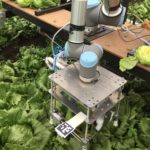 On the surface, agriculture doesn’t appear the most tech-savvy of industries, yet it is one in which considerable innovation is unfolding. Nowhere is this more so than in the advance of robotics that are able to perform a wide range of tasks involved in managing, harvesting and growing crops.
On the surface, agriculture doesn’t appear the most tech-savvy of industries, yet it is one in which considerable innovation is unfolding. Nowhere is this more so than in the advance of robotics that are able to perform a wide range of tasks involved in managing, harvesting and growing crops.
The latest example comes from a recent study from the University of Cambridge, in which a VegeBot device is highlighted that can successfully recognize and harvest iceberg lettuce using machine learning.
The device was initially trained in a lab environment, but has now also undergone successful trials in a range of field conditions. While the VegeBot was successfully able to perform the tasks required of it, it remains significantly slower than human pickers, so it’s a work in progress rather than an inevitable glimpse into our automated future.
Mechanical harvesting
Nonetheless, the results are fascinating as iceberg lettuces have traditionally been very hard to mechanize in the same way that crops such as wheat and potatoes have been already. The iceberg is easily damaged and grows close to the ground, and so is a real challenge for robotic technologies.
“Every field is different, every lettuce is different,” the authors say. “But if we can make a robotic harvester work with iceberg lettuce, we could also make it work with many other crops.”
VegeBot begins by identifying the lettuce within its field of vision, before examining its health and readiness for harvesting. It then removes the lettuce from the rest of the plant in a sufficiently delicate way so as to ensure it’s ready for retail. It’s a process that takes a human a few seconds, but can be difficult for technology to master.
The system achieves this via a computer vision system that is able to accurately identify and analyze the lettuce, and a cutting system that works alongside a second camera to ensure each lettuce is harvested correctly.
The computer vision aspect of the device was trained on example images of lettuces to be able to identify healthy and unhealthy lettuces, firstly in a lab environment and then in the field. The harvesting apparatus was rigorously tested to ensure that the lettuce was held firmly enough to maintain its grip, but not such that it would crush or damage the lettuce.
With the agriculture industry concerned about possible labor shortages in the coming years, the team believe their device could eventually help to ensure that lettuces, and indeed other crops, still find their way to supermarkets.
“We’re also collecting lots of data about lettuce, which could be used to improve efficiency, such as which fields have the highest yields,” the team conclude. “We’ve still got to speed our Vegebot up to the point where it could compete with a human, but we think robots have lots of potential in agri-tech.”
Check out the video below to see VegeBot in action.